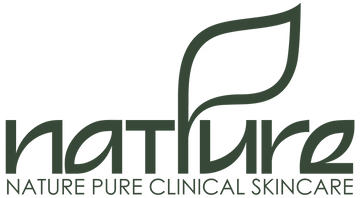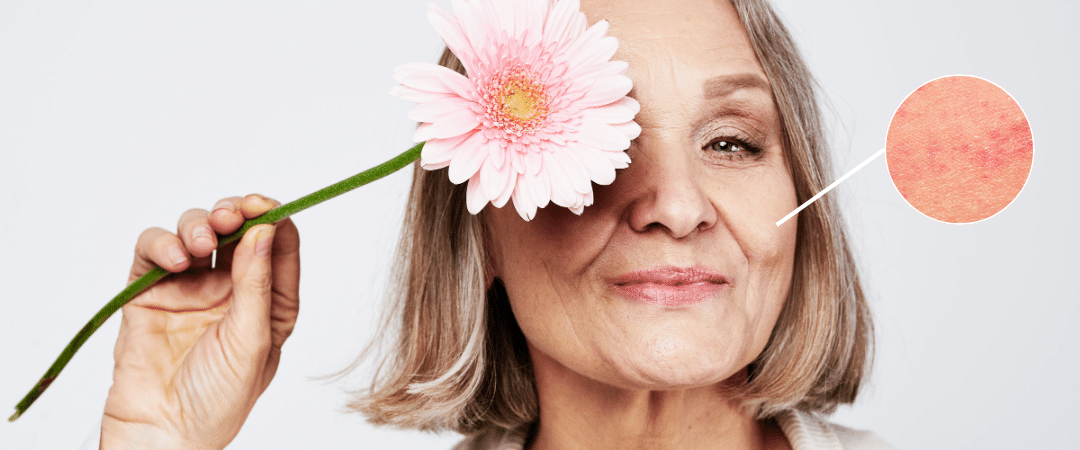The most common symptoms of rosacea, a chronic skin condition, include redness found in the center of the face, especially on the cheeks, nose, forehead, and chin area, and heightened sensitivity. To add, when a woman enters the significant dynamic stages of menopause in her life, hormonal fluctuations and other various physiological changes often can exacerbate rosacea symptoms.
In honor of rosacea awareness month, we want to help you better understand rosacea in menopause by explaining what is actually happening with your skin, raising your awareness of the culprits, and offering you holistic skin and lifestyle remedies to help manage the symptoms.
Rosacea, simplified, is a disorder of the oil glands, so besides the ruddiness and sensitivity, sometimes acne-like bumps can also occur and be particularly troublesome during menopause due to hormonal shifts and other factors.
What’s Happening During Menopause Physiologically?
During menopause, a woman experiences a growing decline in estrogen levels and inactivated estrogen receptors. This internal change leads to a cascade of physiological changes in the skin and body. Estrogen plays a crucial role in maintaining skin health by regulating the production of collagen, skin elasticity and thickness, and a balanced moisture barrier and hydration. As estrogen levels decrease, the skin becomes thinner, drier, and more prone to irritation.
In addition, a histamine response can be triggered in the body as a result of the fluctuating hormones. This would give rise to inflammation and catalyze or worsen rosacea symptoms.
What Can Trigger or Worsen Rosacea Symptoms During Menopause?
- Changes in Hormones – Fluctuating hormone levels can lead to increased sensitivity and inflammation in the skin, triggering rosacea flare-ups.
- Hot Flashes – They are a common symptom of menopause for many women, and can cause flushing and redness, which consequently would worsen rosacea symptoms.
- Stress – Menopause can increase increased stress levels which in turn would cause a rise in cortisol levels among other things and this too can aggravate rosacea.
- Nutritional Culprits – Spicy foods, alcohol, caffeine, and histamine-rich foods can trigger rosacea flare-ups in some individuals.
- Environmental Factors – UV exposure from sunlight, extreme hot or cold temperatures, and harsh weather conditions can intensify rosacea symptoms.
Tips to Help Manage Rosacea Symptoms
While there is no cure for rosacea, our goal is to help you keep the symptoms under control. In addition to skincare, certain lifestyle changes can help manage rosacea during menopause:
- Manage Stress – Plan ahead and prioritize daily activities that will teach and condition you to reduce stress and help alleviate rosacea flare-ups such as daily walks outside, exercise, deep breathing techniques, relaxing facial massage, sound therapy, meditation, or yoga.
-
Protect Your Skin – UV exposure can be a significant trigger to a rosacea flareup, to avoid this, make sure you are using an SPF 30 or higher product and reapplying it as needed throughout the day.
NATURE PURE SUN PROTECTION COLLECTION -
Properly Nourish and Soothe Your Skin – The key actives in your skincare need to have anti-inflammatory, soothing, and moisturizing properties. If the skin’s moisture barrier is balanced and healthy, it will better endure in the face of many culprits.
Your skin needs lipids like ceramides to combat skin dryness.
Ideally, your menopausal skin routine should include the Soy Beauty® products, which are high in lipids and they work to re-educate your skin back to a more youthful state with the action of the patented age-reversing complex.
Calming and capillary repairing ingredients like Arnica Montana Flower, Chamomile, Calendula, and Vitamin K are essential in your daily skin regimen to manage rosacea.
Niacinamide (vitamin B3) found in Skin Lightening Botanical C Serum has anti-inflammatory properties and can help strengthen the skin barrier, reducing redness and irritation.
Azelaic Acid found in Wrinkle Reverse Night Cream is also abundant in other super beneficial and age-defying ingredients like CBD and the fast-acting regenerative, firming, and hydrating action of Glycolic Fruit Acid, SYN®-AKE Peptide, and Hyaluronic Acid, is one of the most effective ingredients for treating rosacea. The intensive anti-inflammatory action of azelaic acid works to decrease swelling and redness of the skin. In the case of acne rosacea, it kills acne-causing bacteria responsible for infecting the pores and increases cell turnover. - Eat Balanced and Well – Maintaining a healthy diet rich in fruits, vegetables, and omega-3 fatty acids is essential. Learning to listen to what your body needs in the form of intuitive eating can be one of the most transformative and empowering ways of supporting overall wellness.
- Stay Hydrated – Drink plenty of water to keep the skin hydrated and help a healthy flow of all of the other processes in the body.
A holistic approach to managing rosacea during the transitional phase of menopause will allow you to enjoy a better quality of life
Stay consistent with your rituals and daily skincare routine that works to meet your skin needs. The primary goals are to keep skin calm, nourished, and moisturized while helping to promote healthy micro-circulation.

